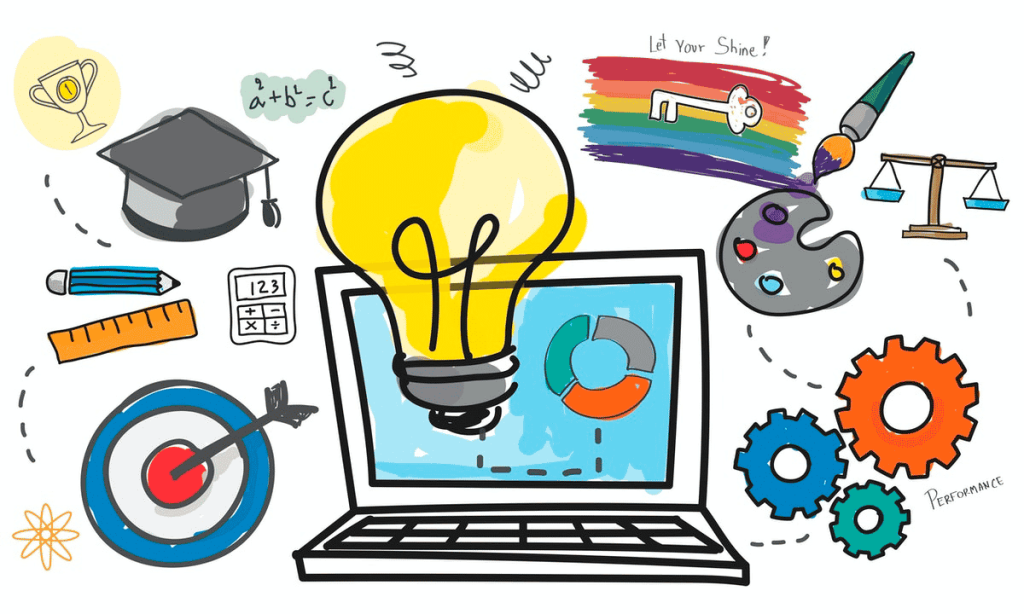
Core Skills for the Future Workplace: A Guide for Employers in 2025 and Beyond
The world of work is undergoing a profound transformation driven by technological advancements, shifting demographics, and global economic changes. These changes in the international labour market will require people to have different skills than they do today. The World Economic Forum estimates that 375 million people will need reskilling by 2025; if this skill gap isn't closed, approximately $11.5 trillion in GDP could be lost.
So, what skills will be in demand in the future, and how can you start preparing for these changes today?
In this article, we will discuss some of these future workplace skills, why they are essential, and how you can identify candidates with these skills in the hiring process effectively.
As we stand at the cusp of a new era, organisations must prepare for a future that promises exciting opportunities and significant challenges.
By identifying professionals with skills like emotional intelligence, creativity, digital literacy, and adaptability, organisations can better equip themselves to navigate the challenges and seize the opportunities presented by the future of work.
What are the main drivers behind the need for future skills?

Digital and Technological Transformation: The process of digital technologies and the incorporation of innovative technologies like AI, Quantum computing, IoT, and robotics have been gaining momentum for some time now, but the rate at which these digital technologies are accelerating.
As the World Economic Forum states, we are entering a fourth Industrial Revolution that will fundamentally change the way we live, work, and interact with each other, enabled by unparalleled technological developments.
As a result, there is a strong need for the upskilling and reskilling of employees as their jobs increasingly involve using these advanced technologies. Additionally, with many roles predicted to be taken over by robots, there will be a growing need for workers who can think creatively, communicate effectively and think critically - the capacities in which technology lacks.
Emerging new business models and workplace transformation: It is no surprise that the global pandemic has dramatically impacted our work. Other factors, like an increasing focus on diversity, inclusion, and sustainability, have also fast-tracked the rise of new business models and the need for transforming the workplace. As existing business models are restructured, new (online) business models emerge, hybrid working is the new normal, and companies are more aware of their social responsibilities, people's jobs, and the skills required to perform them are also changing.
Core Skills for the Future Workplace
As the workplace evolves, specific core skills emerge as essential for success in the future. These skills are in high demand and will likely remain relevant despite rapid technological changes.
Emotional Intelligence
"Emotional Intelligence includes the ability to engage in sophisticated information processing about one's own and other's emotions and the ability to use this information as a guide to thinking and behaviour. That is, individuals high in emotional intelligence pay attention to, use, understand, and manage emotions, and these skills serve adaptive functions that potentially benefit themselves and others" Mayer, Salovey, and Caruso (2008).
Emotionally Intelligence is made up of five components including self-awareness, self-regulation, empathy, Internal motivation and social skills. These skills facilitate the development of solid relationships, and effective communication and drive positive outcomes.
Emotional intelligence (EI) is poised to become a critical skill for the future workforce due to its profound impact on workplace performance and adaptability. As automation increasingly handles routine tasks, uniquely human abilities like EI will become more valuable. Employees with high EI consistently demonstrate better job performance, more vital teamwork, and superior leadership skills. They excel at building relationships, managing stress, and navigating change - all crucial abilities in our rapidly evolving work environments.
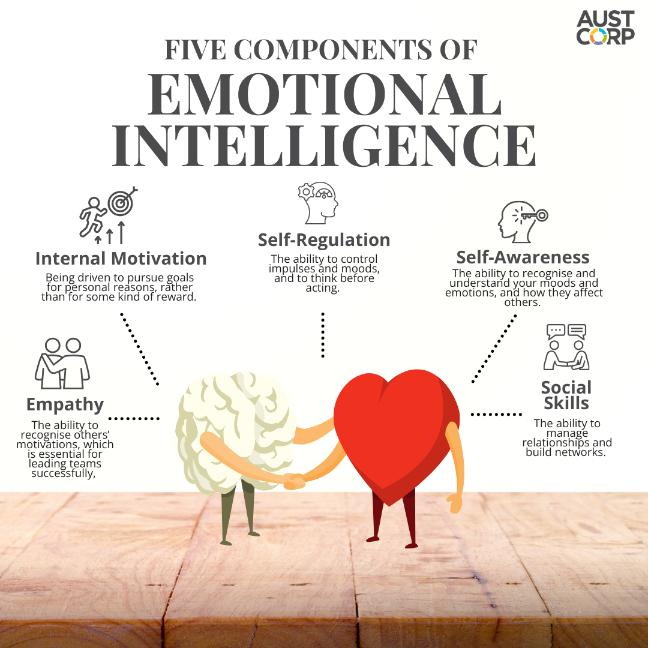
Moreover, EI drives tangible business results, with studiesshowing significant increases in sales and productivity among emotionally intelligent workers. As the workplace becomes more diverse and globally connected, understanding and managing emotions—both one's own and others'—will be essential for effective communication and collaboration.
With 74% of executivesalready viewing EI as a "must-have" skill, it's clear that developing emotional intelligence is beneficial and necessary for success in the future job market.
Identifying Candidates with High EI:
Below are specific techniques and questions for employers to use to identify candidates with high emotional intelligence (EI) during the hiring process.
Strategies to Employ | Description of Strategy |
Administer the Mayer-Salovey-Caruso Emotional Intelligence Test (MSCEIT) or the Emotional and Social Competency Inventory (ESCI) as part of your screening process. These scientifically validated tests provide quantitative EI scores. | |
Emotional Intelligence interview questions will almost always be open-ended, asking the candidate to think more deeply about their answer. These types of questions generally encourage more discourse than a close-ended question. They have no absolute right or wrong answers, but the answers can have a lot of impact on what you will think of the candidate and their suitability for the role.
| |
Scenario Based Questions | These questions follow a slightly different format. They combine emotional intelligence with more scenario-based questions and start with "Tell me about a time when". These questions stump people but are mainly about getting the candidate to describe a specific example that provides a glimpse of their behaviour.
|
Have potential teammates meet candidates to assess cultural fit and interpersonal skills. Gather feedback on the candidate's EI from multiple perspectives. | |
Ask previous employers specific questions about the candidate's empathy, self-awareness, and ability to manage relationships. Some common traits you should enquire about include:
|
For more in-depth guidance on assessing emotional intelligence in hiring, employers can refer to:
The EQ Interview: Finding Employees with High Emotional Intelligence" by Adele B. Lynn
The Consortium for Research on Emotional Intelligence in Organisations
By implementing these targeted techniques, employers can more effectively identify candidates with the emotional intelligence needed to thrive in their organisation.
Creativity
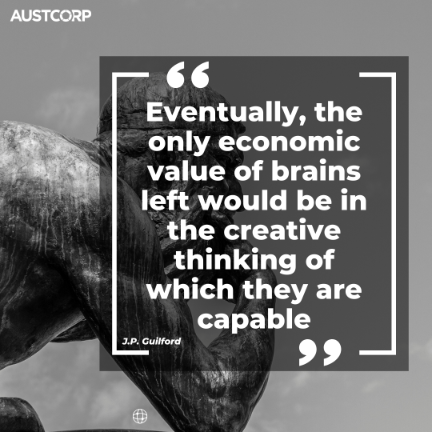
Creativity in the context of the future workplace is far more than artistic expression; it encompasses the ability to think innovatively, solve complex problems, and generate novel ideas. This in-demand skill involves adaptability, out-of-the-box thinking, and the capacity to approach challenges from unique perspectives.
J.P. Guilford noted in 1950, "Eventually, the only economic value of brains left would be in the creative thinking of which they are capable." This observation has become increasingly relevant in our rapidly evolving digital landscape, where routine tasks are increasingly automated.
The importance of creativity for the future workplace is underscored by compelling statistics and driven by technological advancements. LinkedInhas identified creativity as the most in-demand soft skill, reflecting the need for human ingenuity as technology replaces process-driven work. Adobe's research reveals that 78% of employees over 25 desire greater creative ability, while an equal percentage of hiring managers believe creativity is critical to economic growth.
This demand is fueled by the need for innovation in a world of constant change, a world where, as Microsoft CEO Satya Nadella states, "The future of work is not about replacing humans with machines; it's about augmenting human capabilities with technology." As automation and AI take over routine tasks, human creativity becomes essential for problem-solving, developing new products and services, and navigating the complex challenges of a rapidly changing economic and social landscape.
Identifying Candidates with Creative Skills:
Employers can effectively identify highly creative candidates by incorporating targeted techniques into their hiring process. Utilising a combination of validated assessments, behavioural interviews, and practical exercises can reveal a candidate's ability to think innovatively and solve complex problems.
Strategies to Employ | Description of Strategy |
Use validated creativity assessments | Administer tests like the Mayer-Salovey-Caruso Emotional Intelligence Test (MSCEIT) or the Emotional and Social Competency Inventory (ESCI) that measure traits associated with creativity. Utilise personality inventories like the Employee Personality Profile (EPP) or Criteria Personality Inventory (CPI), which evaluate traits like "Openness," correlating with creativity and imagination. |
Scenario Based Questions |
Guidelines for Evaluating Behavioral Responses:
|
Behavioural-Based Questions |
Guidelines for Evaluating Behavioral Responses:
|
Assign small projects related to the job function to evaluate candidates' creative approaches. For example, have sales candidates develop and present a market strategy. You may ask the candidate to create a "curriculum" for the company. This would involve asking the candidate to design how your departments should function, how many employees should be in each department, how many team leaders are needed, hours of work, rate of pay, ect. Although this is a lengthy task, it will force the candidate to learn about the business differently and from an insider's point of view. It would help if you looked for accuracy, business knowledge, ability to follow directions, attention to detail and creativity. | |
Use written response tests: | Design prompts that require candidates to articulate unique and original ideas in writing. Many platformsoffer customisable written response tests that prompt candidates to provide written answers to specific questions or scenarios. You can design test prompts to suit your particular needs, capturing the candidate's creative potential while remaining relevant to your organisation. |
Diagramming Tests | Another way to assess creativity is to employ a diagramming test. It is instructive and tests a candidate's ability to visualise creative solutions to complex problems. Again, many platforms offer software that facilitates these tests. Candidates can create thoughtful diagrams based on unique prompts or problem statements, allowing employers to understand their critical thinking and creative problem-solving skills. |
Cross-cultural/generational communication
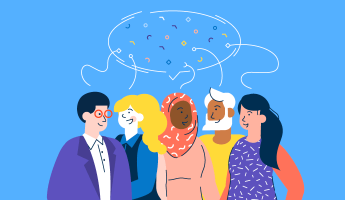
Cross-cultural and cross-generational communication refers to exchanging information and ideas between individuals from different cultural backgrounds or age groups. It encompasses understanding and navigating differences in language, values, beliefs, communication styles, and behavioural norms. This type of communication involves being aware of and adapting to various cultural contexts, generational perspectives, and communication preferences to ensure effective interaction and collaboration.
As the workplace becomes more diverse, with teams spanning multiple countries, cultures, and age groups, communicating effectively across these differences is crucial for success. It enables better collaboration, fosters innovation through diverse perspectives, and helps organisations build stronger relationships with global clients and partners.
Moreover, it plays a crucial role in promoting inclusivity, reducing misunderstandings and conflicts, and allowing companies to leverage the unique strengths and insights of a diverse workforce.
Ultimately, mastering cross-cultural and cross-generational communication will be a key competitive advantage for organisations operating in an increasingly interconnected and multigenerational global economy.
Read more about Cross-Cultural Competency for Leaders here
Identifying Candidates with the ability to communicate across various cultures and generations:
Strategies to Employ | Description of Strategy |
Behavioural interview questions: |
What to Look for in Responses When evaluating candidates' answers to these questions, employers should consider the following criteria:
|
Utilise validated tools like the Cultural Intelligence Scale (CQS)to measure a candidate's ability to function effectively in culturally diverse settings. | |
Conduct group interviews or activities with a diverse set of participants to observe how candidates interact across cultures and generations. | |
Look for candidates with international work or study experience, volunteer work with diverse populations, or involvement in multicultural organisations. | |
Scenario-based Questions: |
What to Look for in Responses When evaluating candidates' answers to these scenario-based questions, employers should consider the following indicators of strong cross-cultural and cross-generational communication skills:
A strong response should demonstrate a nuanced understanding of cross-cultural and cross-generational dynamics, provide specific strategies for effective communication, and show a commitment to creating an inclusive and respectful work environment. Candidates who can provide concrete examples from their past experiences and offer thoughtful, detailed approaches to the scenarios are likely to have well-developed skills in this area. |
Digital Literacy
The rapid evolution of technology is fundamentally altering the employment landscape, creating challenges and opportunities for the global workforce. For instance, a recent report from the World Economic Forum indicates that by 2025, 85 million jobs may be displaced due to the shift in labour dynamics influenced by automation and AI, while 97 million new roles will emerge - all demanding advanced technological skills. Recognising this trend, major tech companies are making substantial investments in employee development programs, with Microsoft alone reported spending $20 billion on training programs over the next five years.

To address the growing need for tech-savvy professionals, educational institutions are revamping their curricula to incorporate cutting-edge technologies like automation, data analytics, and artificial intelligence. For example, a study by McKinsey found that 60% of workers will need reskilling in the next decade due to evolving technology.
Simultaneously, companies like Amazon are shaping future skills directly through programs like their Machine Learning University, which aims to train employees in cutting-edge AI Techniques. This united and collaborative effort between industry and education is crucial, as the demand for digital competencies in the workforce is expected to increase dramatically over the coming years, potentially encompassing more than two-thirds of all jobs by the end of the decade.
Identifying Candidates with Digitial Literacy Skills and the potential to adapt to new technologies:
Strategies to Employ | Description of Strategy |
Digital Literacy Assessments | Use validated tools like the Digital Skills Assessment or TestGorilla's Computer Literacy testto measure proficiency in basic computer operations, internet browsing, digital communication, etc. Employ assessments that cover specific software relevant to the role, such as Microsoft Office or industry-specific applications. |
Scenario-based exercises | Present candidates with real-world digital tasks or problems to solve using specific software or tools. Observe their approach to navigating unfamiliar interfaces or troubleshooting issues. |
Rapid learning challenges | Introduce candidates to a new software or tool during the interview process and ask them to complete a basic task, observing their approach to learning. |
Technical problem-solving tests | Present candidates with common technical issues and assess their approach to resolving them using digital resources. |
Evaluate problem-solving skills | Use problem-solving tests or exercises to assess candidates' ability to analyze complex issues and develop solutions. This skill often correlates with the ability to learn new technologies quickly. |
Data Analysis:

Data analysis has emerged as a critical skill for the future workforce, encompassing the ability to examine, interpret, and derive insights from large datasets to inform decision-making and drive business strategies.
This multifaceted skill involves collecting and cleaning data, applying statistical methods, identifying patterns and trends, creating visualisations, developing predictive models, and translating insights into actionable recommendations.
The importance of data analysis in the workplace is underscored by its role in enabling data-driven decision-making, providing competitive advantages, improving operational efficiency, enhancing customer understanding, and driving innovation.
The demand for data analysis skills is propelled by several factors, including widespread digital transformation, technological advancements in big data and AI, economic uncertainty, a growing skills gap, and increasing regulatory requirements.
This trend is reflected in recent statistics: LinkedIn reports dataanalysis as one of the most in-demand skills for the future workforce, while a McKinsey study found that 60%of workers will need reskilling in data-related skills in the next decade. Furthermore, the World Economic Forum predicts that data analysts will be among the most sought-after professionals by 2025.
As businesses continue to recognise the value of data-driven insights, proficiency in data analysis is becoming an essential competency for workers across various industries, positioning it as a crucial skill for success in the evolving job market.
Identifying Candidates with Data-Analysis Skills:
*These are more specific strategies for Data-analysis skills. However, it is also recommended that general digital literacy testing strategies be incorporated.
Strategies to Employ | Description of Strategy |
Use validated data analysis assessments | Implement tools like TestGorilla's Computer Literacy test or Alooba's Data Analysis skill assessment to evaluate proficiency in data manipulation, statistical analysis, and visualization. |
Assign practical data tasks. | Give candidates a sample dataset and ask them to perform specific analyses or create visualisations within a time limit. Assess their ability to clean data, apply appropriate statistical methods, and communicate findings effectively. |
Review portfolios | Examine candidates' past data analysis projects, paying attention to the complexity of problems solved, tools used, and quality of insights generated. |
Evaluate tool proficiency | Test candidates' skills with relevant data analysis tools like Excel, SQL, R, Python, or Tableau. Assess their ability to manipulate data, create visualizations, and perform statistical analyses using these tools. |
Behavioural Styled Questions | Some examples of behavioural-styled questions relating to data analysis include:
|
Artificial Intelligence and Machine Learning:
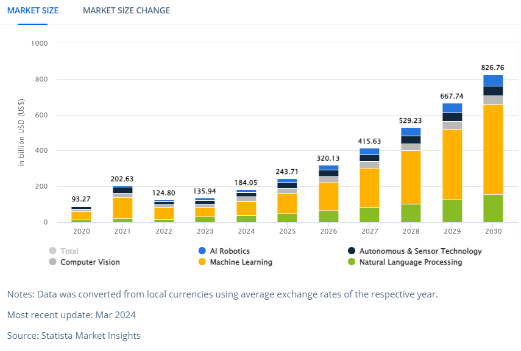
Artificial Intelligence (AI) and Machine Learning (ML) skills have emerged as crucial competencies for the future workforce, encompassing the ability to develop, implement, and work with intelligent systems that learn from data. These skills involve understanding AI/ML concepts, programming in relevant languages, data preprocessing, model development, system deployment, and result interpretation.
The importance of AI/ML skills is driven by their capacity to automate routine tasks, enhance decision-making, improve efficiency, and foster innovation across industries. LinkedIn reports that AI/ML ranks among the most in-demand skills for the future workforce, reflecting its growing significance in the job market.
The surging demand for AI/ML skills is propelled by widespread digital transformation, the increasing availability of big data, advancements in computing power, and the competitive advantage gained through AI implementation. This trend is further supported by statistics showing that 78% of employees over 25 desire greater creative ability, which AI can enhance, and an equal percentage of hiring managers believe these skills are critical to economic growth.
As AI continues to reshape industries, professionals equipped with AI/ML skills will be inspired to drive innovation, improve operational efficiency, and create value in an evolving job market where the ability to work with AI technologies is becoming a fundamental requirement across various roles and sectors.
Identifying Candidates with AI & Machine Learning Skills:
*These are more specific strategies for AI & Machine Learning skills. However, it is also recommended to incorporate general digital literacy testing strategies.
Strategies to Employ | Description of Strategy |
Use validated AI/ML assessments | Implement tools likeTestGorilla's Machine Learning test or specialised AI/ML skill assessments to evaluate proficiency in data manipulation, statistical analysis, and machine learning algorithms. |
Conduct technical interviews | Ask candidates to explain key AI/ML concepts like neural networks, different types of machine learning algorithms, feature engineering, etc. Have them describe how they would approach specific AI/ML problems or scenarios. |
Assign practical coding tasks. | Give candidates sample datasets and ask them to perform analyses or build simple ML models within a time limit. Evaluate their ability to clean data, apply appropriate algorithms, and explain their approach. |
Evaluate tool proficiency | Test candidates' skills with relevant AI/ML tools and frameworks like TensorFlow, PyTorch, scikit-learn, etc. |
Adapability & Resilience
Adaptability and resilience are critical skills for the future workforce, enabling individuals to navigate and thrive in rapidly changing work environments.
Adaptability refers to the ability to adjust quickly to new situations, technologies, and job requirements, while resilience is the capacity to bounce back from setbacks and maintain effectiveness in the face of challenges. In future workplaces, these skills manifest as employees who can seamlessly transition between roles, learn new technologies rapidly, embrace change positively, and maintain productivity even during periods of uncertainty or disruption.
The importance of adaptability and resilience in future workplaces cannot be overstated. As automation and artificial intelligence continue to transform industries, workers must be able to evolve their skills and take on new responsibilities. The World Economic Forumranks adaptability as one of the top 10 skills needed for the future of work, with demand for these skills projected to grow six times faster than other skills in the next 3-5 years.
This demand is driven by factors such as rapid technological advancements, globalisation, economic uncertainties, and the increasing prevalence of remote and hybrid work models. Organisations value adaptable and resilient employees because they can drive innovation, maintain productivity during change, and contribute to a positive work culture that embraces continuous learning and growth.
Identifying Candidates with the ability to adapt and be resilient
Interviews can be powerful tools for evaluating a candidate's adaptability and resilience. Structured questions, situational tests, and assessing past experiences can reveal a candidate's flexibility.
Assessing adaptability and resilience begins with recognising the behaviours and indicators that signal these traits in action. There is no single accepted set of components of resilience, but this set of characteristics and contributing factors can provide a useful guide. It is recommended to keep an eye out for these components when interviewing a potential candidate.
Strategies to Employ | Description of Strategy |
Assess past experiences | Candidates' references can offer unique insights into their adaptability and resilience. Past employers and colleagues are likely to have observed these traits in action. Additionally, a candidate’s employment history might reveal patterns of adaptability or examples of resilience, such as recovering from a job loss or industry shifts. |
Behavioural Questions | Ask about past experiences where the candidate had to adapt to significant changes or recover from a setback. When asking candidates to describe a time when they handled change successfully, you're looking for specific evidence of when they demonstrated their ability to pivot and cope with transitions. Look for detailed examples, such as project direction changes, team dynamics shifts, or new technology introductions. In their responses, the candidate should mention:
Pro Tip: If a candidate includes learning and growth from the experience, it indicates their adaptability and willingness to embrace change effectively. Another question you may pose is, "Tell me about a moment you had to learn something quickly". When evaluating this question, identify responses showing the candidate's ability to acquire new skills and knowledge rapidly. Practical answers should include:
This will outline whether they can learn quickly and effectively apply to change. Pro-Tip: If the candidate describes peer collaboration or searching online for resources, it is a sign that they know how to utilise available resources effectively. |
Personality Assessments: | Tools like the Big Five personality test can offer insights into traits like openness to experience, which is related to adaptability. |
Resilience Scales | Specific scales measure an individual's level of resilience, helping employers predict how they might cope with workplace stress. |
What to look for in answers related to adaptability and resilience:
When assessing responses to adaptability questions, look for specific examples. Candidates who can provide detailed instances from their past experiences often demonstrate high adaptability. Watch for answers that mention exact scenarios where they faced significant change. You want them to illustrate how they identified the change and their specific actions to adjust.
Key Points to focus on:
Direct, clear examples of handling change.
Concrete steps are taken to adjust.
Positive outcomes are a result of their adaptability.
In addition, evaluate the problem-solving skills displayed in their answers. Adaptability often requires quick thinking and effective problem-solving. Look for candidates who explain how they approached challenges logically, adjusted plans, and devised new strategies. This showcases their ability to stay flexible and resourceful under pressure.
Read More Hiring Tips and Guides
Hungry for more hiring advice? Check out these relevant blogs to further enhance your hiring processes:
